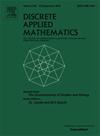Degree sequences for k-regulable ribbon realizations
IF 1
3区 数学
Q3 MATHEMATICS, APPLIED
引用次数: 0
Abstract
The motivation question as to which ribbon graphs have a 4-regular checkerboard colorable twual is posed by Ellis-Monaghan and Moffatt. The ribbon graph is a realization of the sequence if its degree sequence is . Furthermore, we refer to as a -regulable realization of if the realization of has a -regular partial dual. Since any Eulerian ribbon graph has a checkerboard colorable partial Petrial, we attempt to distinguish the ribbon graphs with -regular partial duals directly from their degree sequences. Although the result is frustrating, some sequences lacking -regulable realization are exposed. Moreover, we construct a family of -regulable realizations for all sequences whose elements are greater than 1, except for the sequence when , where the number of 2s and 3s are and , respectively, .
k-可调色带实现的度序列
Ellis-Monaghan和Moffatt提出了一个动机问题,即哪些带状图具有4个规则的棋盘可着色双值。如果序列D的度序列为D,则带状图G是序列D的实现,如果D的实现G具有k正则的部分对偶,则称G为D的k可调实现。由于任何欧拉带状图都有一个棋盘可着色的部分Petrial,我们尝试直接从其度序列中区分具有k-正则部分对偶的带状图。虽然结果令人沮丧,但暴露了一些缺乏k-可调节实现的序列。此外,除了k=3时的序列(2,…,2,3,…,3,5),其中2s和3s的个数分别为3j1−1和2j2−1,j1,j2>0,我们构造了所有元素大于1的序列的k-可调实现族。
本文章由计算机程序翻译,如有差异,请以英文原文为准。
求助全文
约1分钟内获得全文
求助全文
来源期刊

Discrete Applied Mathematics
数学-应用数学
CiteScore
2.30
自引率
9.10%
发文量
422
审稿时长
4.5 months
期刊介绍:
The aim of Discrete Applied Mathematics is to bring together research papers in different areas of algorithmic and applicable discrete mathematics as well as applications of combinatorial mathematics to informatics and various areas of science and technology. Contributions presented to the journal can be research papers, short notes, surveys, and possibly research problems. The "Communications" section will be devoted to the fastest possible publication of recent research results that are checked and recommended for publication by a member of the Editorial Board. The journal will also publish a limited number of book announcements as well as proceedings of conferences. These proceedings will be fully refereed and adhere to the normal standards of the journal.
Potential authors are advised to view the journal and the open calls-for-papers of special issues before submitting their manuscripts. Only high-quality, original work that is within the scope of the journal or the targeted special issue will be considered.
 求助内容:
求助内容: 应助结果提醒方式:
应助结果提醒方式:


